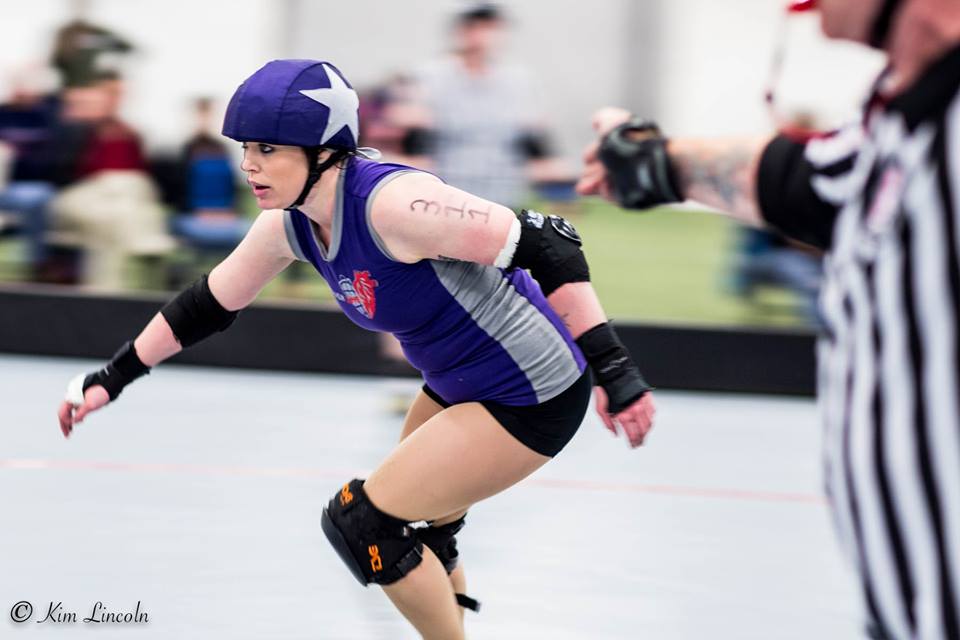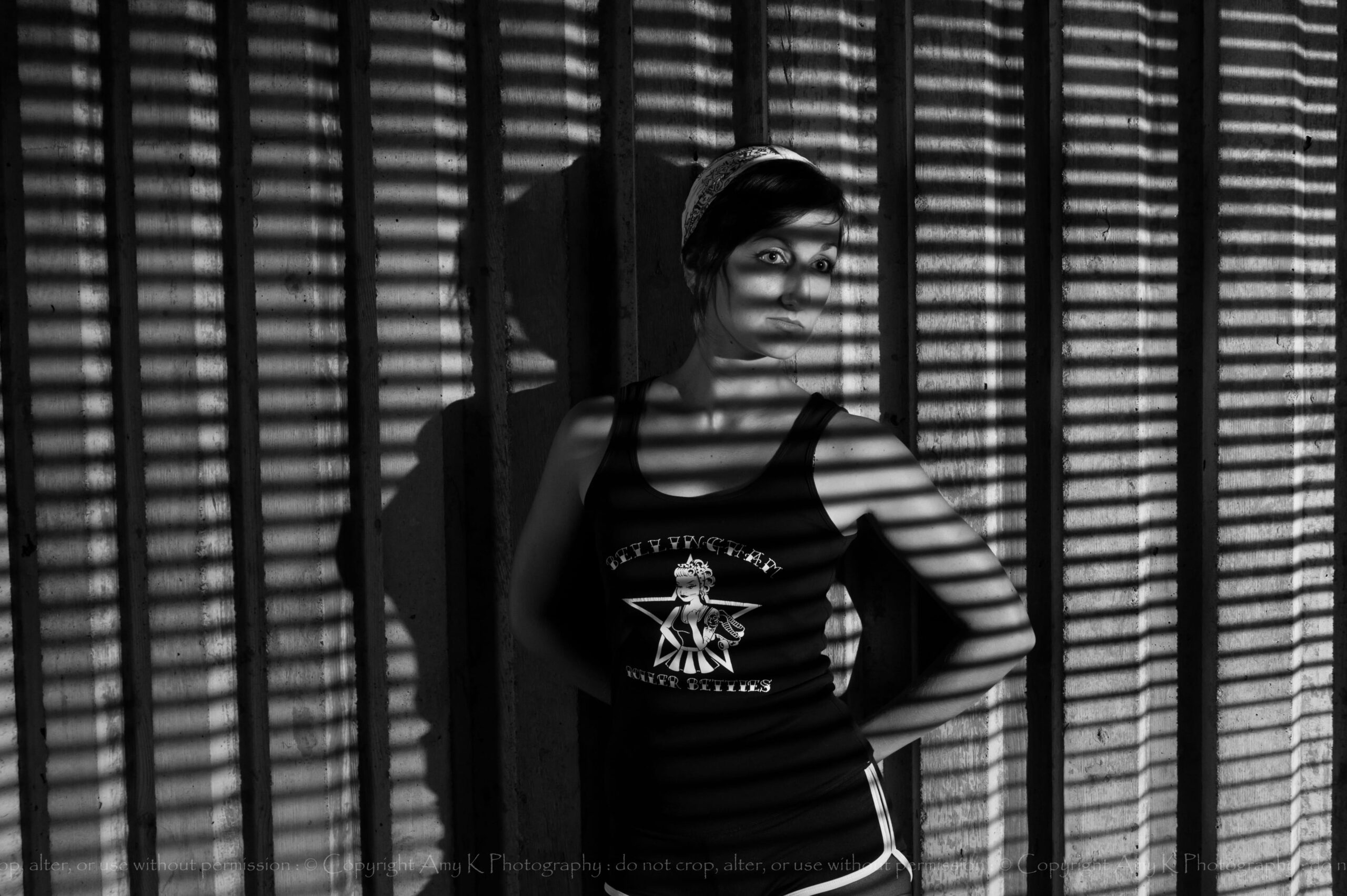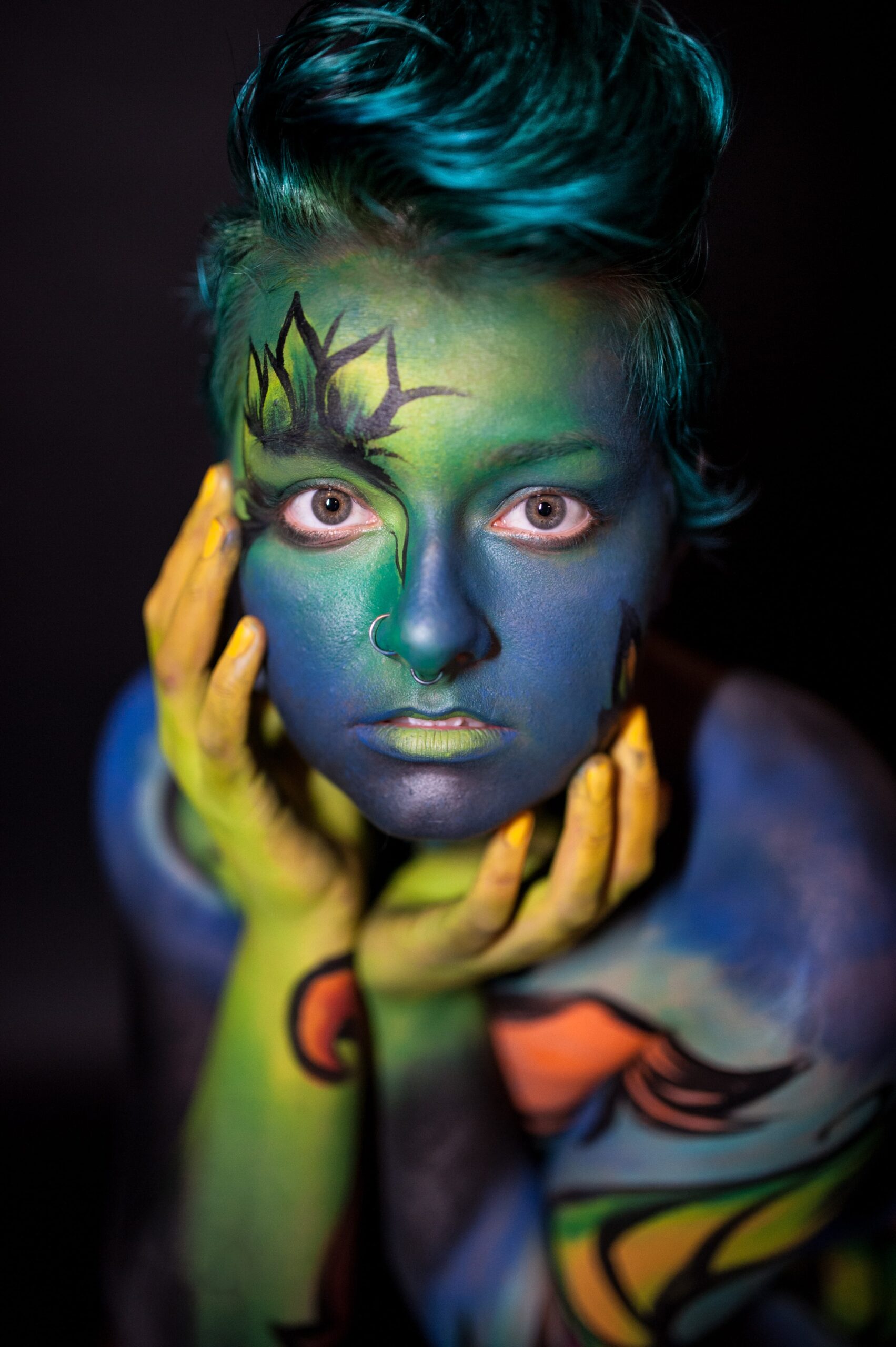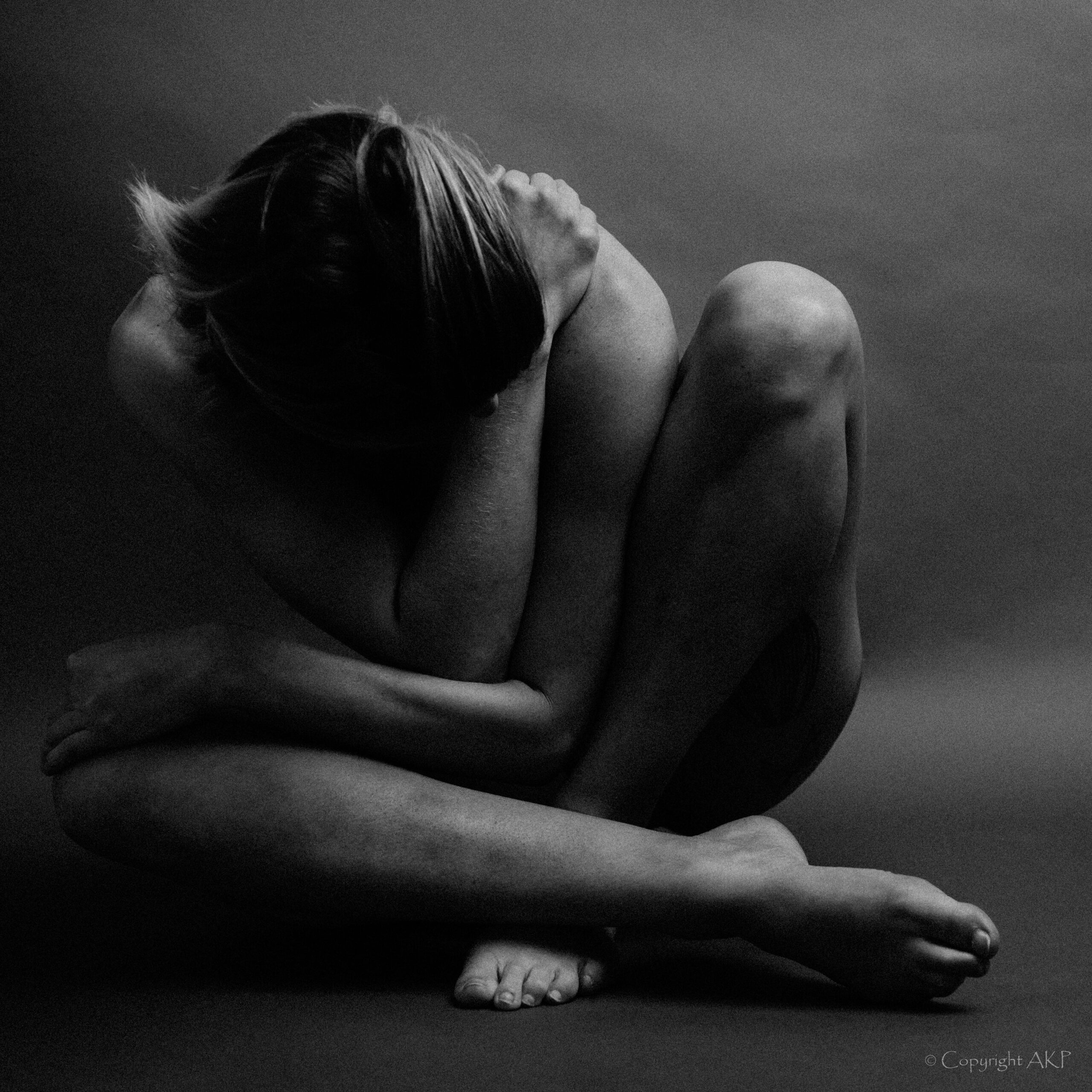In the Raw: Skates to Skin Collaborative Photography
An Interview with Kim Lincoln and Amy Woodward
Jocelyn Marshall, creative nonfiction editor and a Bellingham Roller Betty, continues our interest in collaborative artwork by interviewing Kim Lincoln and Amy Woodward, two local artists who specialize in photographing roller derby. Here, they discuss their collaborative process and their development as artists.
Jocelyn Marshall, Bellingham Review: Can you tell me a little bit about how you two began working together?
Kim Lincoln: In 2010, I started photographing the Bellingham Roller Betties. It was my sister’s freshmeat year[1], and she asked me to photograph. I showed up, but I was very overwhelmed. I had never shot sports. Ever. I had interviewed athletes before, but had never photographed them. After a few bouts[2], I thought, “I need somebody that I can count on, who I click with, who can help me.”
I didn’t even know Amy, and I just saw her with a camera at a Scout meeting, the Pinewood Derby Race, because we both had little kids.
Amy Woodward: And we both had our cameras there and went, “Oh, there’s a kindred spirit.”
KL: Yes, so I’m taking head shots of little kids and Amy’s sitting there, and I said, “Hey! Would you be interested in helping me with roller derby? It doesn’t pay anything, but it’s a lot of fun.” And she just said, “Sure! Get ahold of me, and let’s make this happen.”
JM: Amy, had you been to a derby bout before?
AW: I had been once, and I didn’t know anything about it. My husband and I went on a date night, and I found it extremely fascinating. I wanted to be one of those people, but I have yet to try out because I want to know the rules better. I try and follow the photos to figure it out, but I still can’t do it.
I figure I’m a portrait photographer that now shoots derby; I’m not a derby photographer that shoots portraits. And I think that’s what makes us interesting. We started out—
KL: —doing portrait photography, personal photography—
AW: —and learned sports photography without intending to.
KL: You have to learn how to anticipate action. You have to learn when to shoot, when not to shoot.
AW: The whole culture of it.
JM: What do you think cultivates this draw to derby or derby culture (wanting to photograph it and maybe even become a part of it)?
AW: The draw, for me, was my happy space. Taking pictures of people, of families, is fun, but you don’t get to be creative with it. And when you get to derby, you have all of these people that are special, somehow. When you go to a hockey game, you’re going to get hockey players. When you go to a volleyball tournament, you’re going to get volleyball players. When you go to derby, you get the full gambit. And that’s what appealed to me. I thought, “I want to be a part of this,” because it was so diverse. That’s what drew me in, the diversity of it.
KL: For me, my sister and I grew up skating. We’d skate in our garage to the Top Gun and Dirty Dancing soundtracks. I thought this could be where I use the skills of skating and photography together. Derby is just so fascinating and so much fun to photograph. And for the most part, derby bouts are not posed. It’s all candid; it’s not contrived.
AW: It’s a challenge! It’s not just that it’s challenging. It’s that it’s a challenge because you want to accomplish it, you want to do it well.
KL: And coming from a no-sports photography background, there’s been a steep learning curve for us.
AW: And we’ve learned together. I wouldn’t be doing this if Kim weren’t doing this, and I think she likely wouldn’t be doing this if I weren’t.

JM: How did you get started with this learning process?
KL: The Lynden[3] skating rink is terrifying because the lighting is terrible and the floors are reflective. I came with the knowledge I had, which was the knowledge I learned in school. I had my on-board flash[4] and was trying to figure out how to make this happen. And it was just kind of a wreck.
AW: We had only ever done natural light photography up until that point. Derby was my first introduction to off-camera flash[5].
KL: From there I decided that if I was going to make this good, I would have to step it up and I needed to learn how to do this. So I went from one flash, to two flashes, to three flashes, to four flashes, and modifiers, and stands, and placement to learn what works.
AW: Video tutorials, groups, discussions, classes, books—
KL:—we did a workshop in Canada, and we’ve done mainly online tutorials.
JM: With this addition of gear, your techniques must have expanded. Can you talk a little bit about how your approach maybe changed as a result?
AW: The gear kind of exploded. The dynamic changes constantly, and I feel like just this year—we can still kind of go crazy—but we’re in a place where we can handle it all, we’re in charge of it, and can decide if we want a one-light setup, or two, or three, or six. Or, if we’ll go with a key [light][6], or with a rim [light][7].
We’re constantly learning. The more you learn, the more you realize there’s more to it. And we’ve not only learned about off-camera flash, but have learned about light, period. So even if we look at our natural-light stuff from five years ago and compare it to our natural-life stuff of this year, it’s really remarkable. We used to take pictures of people, and now we take pictures of light on people.
JM: You photograph with separate cameras, yet produce the same project in the end. How does that collaborative process work? Do you help each other setup shots, or maybe count on strengths and weaknesses you know about one another?
KL: I think it starts with an idea. One of us will get a light bulb, and say, “Let’s try this, let’s try body paint, let’s do a dancer, let’s do a nude with tulle.” Something will come to mind, and I’ll either write it down or type out a list.
AW: We’re in constant communication. We have notebooks, lists on our computers—
KL: —slips of paper everywhere.
AW: And we’ll have exploring days and just go explore. One of us will say, “Hey, I’ve got the morning off. Let’s get in the car and go see what we can find.” And we make a list of places we want to go to, and then we’ll take off and check them out. When we see places, it triggers ideas. We’ll shoot the place, we’ll shoot each other, and any of our kids who are home sick for the day. It’s a really organic process.
KL: It always starts with an idea. Then we think about who would fit that idea, and we just move forward. We book it, we chat a lot online, and maybe we’ll bring in images from online to help inspire us.
AW: Because our lives are so busy with families, kids, jobs, it’s never the formal thing where we sit down in a room and say, “Let’s get to work!” It’s a message at one in the morning saying, “Hey, I want to do this.”
KL: I think the only exception was when we did bare derby[8]. That was very organized. We had so many people to work with. It was a sensitive and vulnerable project, and we needed to make sure each woman knew what to expect. So we made a storyboard with specific poses for each woman. We gave each woman about a month or so to work on the specific pose. We did a lot of research about how to make sure each woman felt the best she could and empowered. We talked to each of them extensively. We asked, “What do you love about your body? What do you hate about your body? How do you want your body to be represented in these images?” That was a huge process.
AW: Kim and I each have our own visions for projects, but we just work together so naturally and so beautifully. It’s nice to have somebody to flesh it out with. Kim and I are happy with the place we are at because we’re not competitive with one another. We’re encouraging of one another.
KL: I feel like we each have a healthy amount of humility so that we’re not competing. I care as much about her creative process as I care about mine. It’s important to me. I want her to grow as much as I want to grow.
AW: —to create success in the other. We both shoot different gear; she’s Canon and I’m Nikon. She shoots warm; I shoot cool[9]. Our editing processes are different, and we use different software. But, it’s just so fun to do it with somebody else. There’s no pressure.
KL: Right. This is not paid work. They are completely creative endeavors. This is our outlet. We’re moms, we’re busy, and we both have an inherent creative nature that has to get out. This is the way that we choose to express it. It’s really nice to have somebody else who’s on that same page and can understand.
JM: It sounds like this process, free of jealousy, allows for the final product to represent this earnest collaboration.
KL: Yes. Each person we photograph gets a separate album: one from her and one from me because our styles are so different. And then that person can do what they wish with the photographs. They volunteered their time to stand still, for example, and be painted for three hours.
AW: I think having two of us together makes it easier for the person that we’re photographing. Because we’re going in raw and real—we’re trying to find a way to describe it when we talk about what we’re shooting—because what we want to do is nudes, and it’s helpful to have each other there because it’s tough for people to expose themselves. It’s your soul and your spirit; it’s not trying to put you into overly sexualized poses.
JM: Where does this interest in nudes come from?
AW: Vulnerability. Real. Authenticity.
KL: We want to capture real emotion, real beauty. I don’t want the fully made-up hair, makeup. That’s not who you are when you wake up in the morning. We’re not good at the boudoir[10], which is very stylized. I don’t feel like that’s authentic.
JM: It seems like you’re taking this “raw” concept in both the literal and metaphorical sense, where you literally want your subjects naked and exposed.
AW: —Even if you’re not naked, but it takes having to take off your clothes for people to have access to that. Because we’re always walking around with walls up, we’re posturing. It’s all posturing.
KL: And when you put a camera in front of somebody, it’s even more so.
AW: So when you take away the posturing, the identifiers, the qualification, what are you left with? And that’s extremely difficult. Wrapped in tulle you’re not nude, but you’re exposed. And not just exposed in the visual sense, but you’re exposed in the emotional. This is how we get to see a bit of somebody’s soul because you get to understand what’s in their soul based on how they’re even responding.
KL: We’ve done sessions in the exact same light and exact same settings, and have had completely different results—
AW:—where one woman is in tears because she is so completely overcome with the fact that we’re in our creative process—and we’re never going to b.s. somebody and say, “oh, it’s beautiful, it’s wonderful”—but when we’re seeing something in our lens and our eye and go, “That’s beautiful! Stop. Look toward me. Look out the window. Go some place in your head that you’re able to access,” and that transition, and seeing that flood, that’s success.
ADVICE FOR THOSE INTERESTED IN A COLLABORATIVE PROJECT
Check your ego at the door.
Yes, humility and ego.
Find somebody who is encouraging instead of discouraging.
Care about each other’s growth.
Do the learning process together. Go to classes together.
Notes:
[1] Freshmeat: a roller derby skater’s first year
[2] Roller derby games/matches
[3] Lincoln: I love Lynden Skateway, but for photography purposes it’s challenging.
[4] The flash unit built-in to the camera.
[5] Flash units that are either mounted on top of the camera or mounted on a light stand (not built-in to the camera).
[6] Used to highlight form and dimension of the subject.
[7] Used to create backlighting, where the subject is lighted from behind causing facial features of the profile to be highlighted.
[8] A few selected Bellingham Roller Betties skaters were selected to do a derby-themed nude shoot in Spring 2014. Prints were posted in a local Bellingham restaurant during June and July, and much of the proceeds went to the Betties’ Season 7 community partner.
[9] “Warm” and “cool” refer to camera settings for white balance, which can be adjusted using degrees along the Kelvin system.
[10] Woodward: Some people are very good at that, and it’s authentic for some. And other photographers do a really good job at that. And I could never do that well.
JOCELYN MARSHALL is a creative nonfiction writer and MA candidate in English studies at Western Washington University. Her work features themes of gender and sexuality rooted in transnationalism and women of color feminism. She is a creative nonfiction editor for the Bellingham Review, part-time instructor at WWU, and a proceedings coordinator at SPIE.


